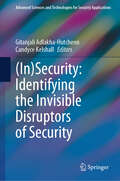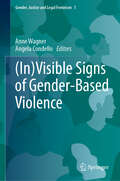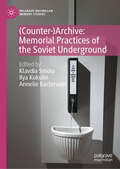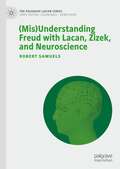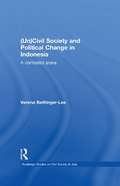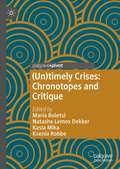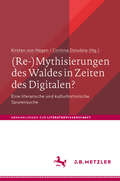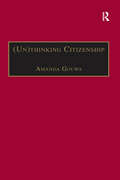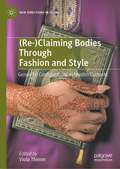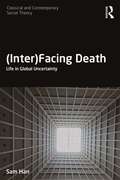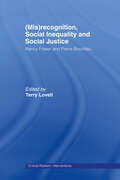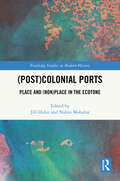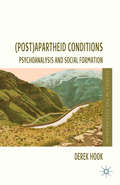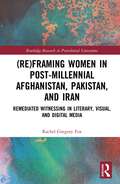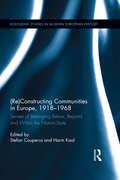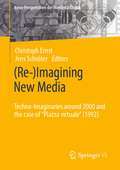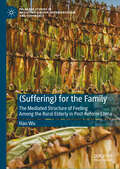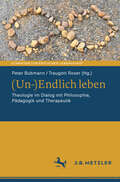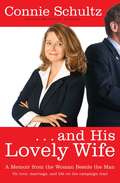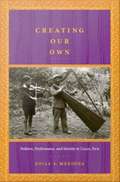- Table View
- List View
**Missing** (Advanced Sciences and Technologies for Security Applications)
by Gitanjali Adlakha-Hutcheon Candyce KelshallWhat does it take to disrupt security? How does one disrupt the invisibility of insecurity? How does one make the invisible factors that define and impact security visible? For a start, by giving voice to the unheard and the marginalized, engaging non-traditional understandings of security that might bring to light the cracks in our current security infrastructure and expose the insecurities that are hidden in plain sight. These voices include generational, geographic, cultural, ethnic, and gender-based perspectives of insecurity which are ignored, or simply cannot be heard, by traditional notions of security. Presently there is a lack of understanding of the language of nuanced hate being whispered from the ground that inform civil discord. These call for new intrastate actions that need to be taken to make communities safer and building layers of protective resilience into the continuing existence of the state. Unresolved grievances lay the foundation for insecurity and instability for the future at a time when states need cohesiveness more than ever and there are significant invisible insecurities, external to the state, that need to be revealed. The tapestry of interrelationships that enable security within a state requires equity, access, and agency among communities. If we are to achieve this, we must learn to see the invisible, listen to the unheard, and move beyond our static conceptions of security. In so doing we build more resilient societies in the face of a dynamic threat environment and ensure the peaceful continued existence of states. This book is a sounding board for positive disruption, a source for alternative theories, tools, and models to aid mitigation of the whispered threats and the soft violence which accompanies chauvinism of any one way of being. In this edited book the multiplicity of factors that impact security is explored through new lenses to glean insights, such that we are better equipped to prevent harm and protect our security.
**Missing** (Gender, Justice and Legal Feminism #1)
by Anne Wagner Angela CondelloThe edited volume explores the causes, forms, and cultures of gender-based violence in society, including how children are educated, how games, art and even language promote differences, stereotypes, neutrality between men and women. It is a place to reflect on the growing importance of tolerance, diversity and acceptance of others. The book focuses on many facets, whether in a confined or public space, with a series of empirical and theoretical chapters from around the world. The volume provides key contemporary commentary on the changing dynamics of gender-based violence. It unveils a range of contexts and spaces in which gender-based violence happens, showcasing its scale and impact worldwide. The discussions presented in the book encourage a critical reflection on the global pandemic of gender-based violence, prompting a vital question about the sufficiency and effectiveness of responses to this global crisis (Professor Olga Jurasz, The Open University Law School).
**Missing** (Palgrave Macmillan Memory Studies)
by Klavdia Smola Ilya Kukulin Annelie BachmaierThis book is the first major study exploring archival and memorial practices of the Soviet unofficial culture. The creation of counter-archives was one of the most important forms of cultural resistance in the Soviet Union. Unofficial artists and poets had to reinvent the possibilities of maintaining art and literature that “did not exist”. Against the background of archival theories and memory studies, the volume explores how the culture of the Soviet underground has become one of the most striking cases of scholarly and artistic (self-)archiving, which – although being half-isolated from the outer world – reflected intellectual and artistic trends characteristic of its time. The guiding question of the volume is how Soviet unofficial culture (de)constructed social memory by collecting, archiving and memorizing tabooed culture of the past and present.
**Missing** (The Palgrave Lacan Series)
by Robert SamuelsThis book sets out to clarify five key Freudian concepts (the pleasure principle, the primary processes, the unconscious, transference, and the reality principle) elaborated early on in Freud’s work but, it is argued, rarely understood—even by psychoanalysts themselves. It examines in turn the post-Freudian paradigms employed in neuropsychoanalysis, Lacan, Zizek, object relations, and psychoanalytic approaches to identity politics, and in doing so reveals the extent to which they have been distorted and repressed in these new contexts. Over the course of the book the author demonstrates how Freud’s unpublished Project for a Scientific Psychology can be seen as a complete system of core concepts that both ground psychoanalysis in neurology and also introduce a vital challenge to the brain sciences. This book will appeal to students and scholars of psychoanalysis, clinical psychology, and psychoanalytic theory.
**Missing**: A Contested Arena (Routledge Studies on Civil Society in Asia)
by Verena Beittinger-Lee(Un) Civil Society and Political Change in Indonesia provides critical analysis of Indonesia’s civil society and its impact on the country’s democratization efforts that does not only take the classical, pro-democratic actors of civil society into account but also portrays uncivil groups and their growing influence on political processes. Beittinger-Lee offers a revised categorization of civil society, including a model to define the sphere of ‘uncivil society’ more closely and to identify several subcategories of uncivil society. This is the first book to portrays various uncivil groups in Indonesia, ranging from vigilantes, militias, paramilitaries, youth groups, civil security task forces and militant Islamic (and other religious) groups, ethnonationalist groups to terrorist organizations and groups belonging to organized crime. Moreover, it provides the reader with an overview of Indonesia’s history, its political developments after the democratic opening, main improvements under the various presidents since Suharto’s fall, constitutional amendments and key reforms in human rights legislation. This book will be of interest to upper level undergraduates, postgraduates and academics in political science and Southeast Asian studies.
**Missing**: A Sociology of the Everyday (Asia in Transition #20)
by Noor Hasharina Hassan Paul J. Carnegie Lian Kwen FeeThis thoughtful and wide-ranging open access volume explores the forces and issues shaping and defining contemporary identities and everyday life in Brunei Darussalam. It is a subject that until now has received comparatively limited attention from mainstream social scientists working on Southeast Asian societies. The volume helps remedy that deficit by detailing the ways in which religion, gender, place, ethnicity, nation-state formation, migration and economic activity work their way into and reflect in the lives of ordinary Bruneians. In a first of its kind, all the lead authors of the chapter contributions are local Bruneian scholars, and the editors skilfully bring the study of Brunei into the fold of the sociology of everyday life from multiple disciplinary directions. By engaging local scholars to document everyday concerns that matter to them, the volume presents a collage of distinct but interrelated case studies that have been previously undocumented or relatively underappreciated. These interior portrayals render new angles of vision, scale and nuance to our understandings of Brunei often overlooked by mainstream inquiry. Each in its own way speaks to how structures and institutions express themselves through complex processes to influence the lives of inhabitants. Academic scholars, university students and others interested in the study of contemporary Brunei Darussalam will find this volume an invaluable resource for unravelling its diversity and textures. At the same time, it hopefully stimulates critical reflection on positionality, hierarchies of knowledge production, cultural diversity and the ways in which we approach the social science study of Brunei. ‘I wish to commend the editors for bringing this volume to fruition. It is an important book in the context of Southeast Asian sociology and even more important for the development of our social, geographical, cultural and historical knowledge of Brunei.’ —Victor T. King, University of Leeds
**Missing**: Chronotopes and Critique (Palgrave Studies in Globalization, Culture and Society)
by Maria Boletsi Kasia Mika Ksenia Robbe Natashe Lemos DekkerUn)timely Crises explores how ‘crisis’—as a narrative, concept, grammar, and experience—structures time and space. This collectively written volume extends Bakhtin’s ‘chronotope’ to challenge mobilizations of crisis within neoliberal governmentality. The book explores how contemporary crises can trigger memories and traumas of earlier events as well as foster practices of resistance and alternative visions of the future. Drawing from across disciplines and geographical contexts, (Un)timely Crises reimagines the relation of ‘crisis’ with ‘critique’, proposing future trajectories for thinking and living in and through crisis.
**Missing**: Diverse and Divergent Place-Making of People on the Move (Worlds in Motion #14)
by Nanneke Winters, Heike Drotbohm and Yaatsil Guevara GonzálezPeople who are “on the move,” particularly migrants and the displaced, often inhabit places that are considered temporary, peripheral, and remote. (Un)Settling Place recentralizes these “out-of-the-way” places as key sites in the shaping of people’s mobility and identities. Ranging from the surveillance and care that migrants experience to the re-creation of social ties and the re-claiming of space, this collection volume seeks to show how a critical approach to in-between place-making can challenge the idea of place as fixed, singular, or one-directional, offering new ways of understanding migrant trajectories.
**Missing**: Eine literarische und kulturhistorische Spurensuche (Abhandlungen zur Literaturwissenschaft)
by Corinna Dziudzia Kirsten Von HagenAktuell ist Wald in öffentlichen Diskursen zentral, verbunden mit einer Re-Mythisierung, die zum einen als Effekt einer ökologisch bedingten Krise und zum anderen als Folge einer Primordialität des Digitalen zu lesen ist. Wald ist Anti-Digitalität, weil umfassend sinnlich erfahrbar. Umso mehr sich gerade das Buch in seiner Materialität vom Wald als rohstoffliefernder Grundlage entfernt, wird der Wald Thema in Ecocriticism, Kulturökologie und Nature Writing. Doch der Wald hat immer schon zahlreiche Mythisierungen erfahren, als Schutz- und Inspirationsort ebenso wie als Denkfigur lassen sich zahlreiche Inszenierungsformen beobachten, die von Dante bis zu aktuellen Serien, Filmen und Comics führen. In den nun versammelten Beiträgen einer neuen nachhaltigen Form von Online-Studientagen wird der Ubiquität des Waldes aus einer interdisziplinären Perspektive nachgespürt.
**Missing**: Einstellungen zu Migranten in Deutschland und Europa (Blickpunkt Gesellschaft)
by Pascal Siegers Sonja Schulz Oshrat Hochman Bettina WestleDieser Band versammelt verschiedene Untersuchungen zu Einstellungen zu Migranten und zu nationalistischem Wahlverhalten, die alle auf repräsentativen Bevölkerungsumfragen beruhen. Insgesamt verdeutlicht die Gesamtschau der in diesem Band versammelten Beiträge die Bedeutsamkeit von (positiven) Kontakten zwischen der deutschen Aufnahmegesellschaft und der Migrantenpopulation. Hinweise auf eine allgemeine Verschlechterung des Meinungsklimas gegenüber ethnischen Minderheiten ergeben sich aus den Studien nicht. Sofern Migration nicht als Bedrohung für den eigenen Status wahrgenommen wird, kann verstärkter Kontakt dazu führen, dass die deutsche Bevölkerung insgesamt toleranter und offener wird. Im Gegenschluss kann eine wahrgenommene Bedrohung des eigenen Status und der eigenen Ressourcen zu einer gesellschaftlichen Polarisierung führen. Der Wandel hin zu einer größeren Akzeptanz Zugewanderter ist also nicht irreversibel: Die „offene Gesellschaft“ in der Bundesrepublik muss ständig aktiv erarbeitet werden.
**Missing**: Feminist Debates in Contemporary South Africa (Gender in a Global/Local World)
by Amanda GouwsThe study of citizenship in the context of South Africa implicitly challenges the rights-based democracy in South Africa, while literature regarding women and citizenship has greatly contributed to a new understanding of citizenship. Locally, many global processes are reproduced in the discourse of rights-claiming, issues of institutional representation, bodily integrity in the face of violence, and care in the face of a lack of care. This volume takes the debate of citizenship in South Africa in a more theoretical and empirical direction while engaging with knowledge produced elsewhere in the world. As part of the Gender in a Local/Global World series, it investigates the making of gendered citizenship, institutionalization of gender politics, the state of gendered policy making, local citizenship, rights, the women's movement, gendered violence, as well as citizenship and the body.
**Missing**: Gendered Configurations in Muslim Contexts (New Directions in Islam)
by Viola ThimmThis book investigates ways of dressing, style and fashion as gendered and embodied, but equally as “religionized” phenomena, particularly focusing on one significant world religion: Islam. Through their clothing, Muslims negotiate concepts and interpretations of Islam and construct their intersectionally interwoven position in the world. Taking the interlinkages between ‘fashionized religion,’ ‘religionized fashion,’ commercialization and processes of feminization as a starting point, this book reshapes our understanding of gendered forms of religiosity and spirituality through the lens of gender and embodiment. Focusing mainly on the agency and creativity of women as they appropriate ways of performing and interpreting various modalities of Muslim clothing and body practices, the book investigates how these social actors deal with empowering conditions as well as restrictive situations. Foregrounding contemporary scholars’ diverse disciplinary, theoretical and methodological approaches, this book problematizes and complicates the discursive and lived interactions and intersections between gender, fashion, spirituality, religion, class, and ethnicity. It will be relevant to a broad audience of researchers across gender, sociology of religion, Islamic and fashion studies.
**Missing**: Geographies and Regulation of the Sex Industry (Routledge Advances in Sociology)
by Paul J. Maginn Christine Steinmetz(Sub)Urban Sexscapes brings together a collection of theoretically-informed and empirically rich case studies from internationally renowned and emerging scholars highlighting the contemporary and historical geographies and regulation of the commercial sex industry. Contributions in this edited volume examine the spatial and regulatory contours of the sex industry from a range of disciplinary perspectives—urban planning, urban geography, urban sociology, and, cultural and media studies—and geographical contexts—Australia, the UK, US and North Africa. In overall terms, (Sub)urban Sexscapes highlights the mainstreaming of commercial sex premises—sex shops, brothels, strip clubs and queer spaces—and products—sex toys, erotic literature and pornography—now being commonplace in night time economy spaces, the high street, suburban shopping centres and the home. In addition, the aesthetics of commercial and alternative sexual practices—BDSM and pornography—permeate the (sub)urban landscape via billboards, newspapers and magazines, television, music videos and the Internet. The role of sex, sexuality and commercialized sex, in contributing to the general character of our cities cannot be ignored. In short, there is a need for policy-makers to be realistic about the historical, contemporary and future presence of the sex industry. Ultimately, the regulation of the sex industry should be informed by evidence as opposed to moral panics. *** Winner of the Planning Institute of Australia (WA) 2015 Award for Excellence in Cutting Edge Research and Teaching ***
**Missing**: Life in Global Uncertainty (Classical and Contemporary Social Theory)
by Sam HanIn modern times, death is understood to have undergone a transformation not unlike religion. Whereas in the past it was out in the open, it now resides mostly in specialized spaces of sequestration—funeral homes, hospitals and other medical facilities. A mainstay in so-called traditional societies in the form of ritual practices, death was usually messy but meaningful, with the questions of what happens to the dead or where they go lying at the heart of traditional culture and religion. In modernity, however, we are said to have effectively sanitized it, embalmed it and packaged it—but it seems that death is back. In the current era marked by economic, political and social uncertainty, we see it on television, on the Internet; we see it almost everywhere. (Inter)Facing Death analyzes the nexus of death and digital culture in the contemporary moment in the context of recent developments in social, cultural and political theory. It argues that death today can be thought of as "interfaced," that is mediated and expressed, in various aspects of contemporary life rather than put to the side or overcome, as many narratives of modernity have suggested. Employing concepts from anthropology, sociology, media studies and communications, (Inter)Facing Death examines diverse phenomena where death and digital culture meet, including art, online suicide pacts, the mourning of celebrity deaths, terrorist beheadings and selfies. Providing new lines of thinking about one of the oldest questions facing the human and social sciences, this book will appeal to scholars and students of social and political theory, anthropology, sociology and cultural and media studies with interests in death.
**Missing**: Nancy Fraser and Pierre Bourdieu (Critical Realism: Interventions (Routledge Critical Realism))
by Nancy Fraser Pierre BourdieuNancy Fraser’s work provides a theory of justice from multiple perspectives which has created a powerful frame for the analysis of political, moral and pragmatic dilemmas in an era of global capitalism and cultural pluralism. It has been developed through dialogue with key contemporary thinkers, including an extended critical exchange with Axel Honneth that touches importantly upon the work of the late Pierre Bourdieu on social suffering. All the essays collected here engage with the work of one or both of these thinkers’. They consider some of the conceptual and philosophical contentions that Fraser’s and Bourdieu’s models have provoked, and offer some compelling examples of their analytical power.
**Missing**: Our Knowledge, Our Process, Our Choice (SUNY series, Critical Race Studies in Education)
by Chrystal A. George Mwangi; Yedalis Ruíz SantanaOffers novel frameworks and models for understanding college access and choice among communities of Color.This much-needed volume brings together academics, practitioners, students, and community members of Color to thoroughly reframe college access and choice in research and practice. Enrollment rates continue to differ substantially by race and ethnicity. While Black, Indigenous, and other People of Color remain inequitably stratified in the pursuit of higher education, many models of college choice are simply insufficient for understanding the college-going processes of diverse students. Continually centering BIPOC knowledge, assets, and needs, contributors provide a series of varied yet connected frameworks grounded in culturally sustaining, community-oriented research. Like the educational journeys it represents, the volume is a communal activity that invites participation. Each chapter concludes with a series of critical reflection questions to guide readers in deeper learning and engagement.
**Missing**: Place and (Non)Place in the Ecotone (Routledge Studies in Modern History)
by Jill Didur Nalini MohabirThis book examines the role of (post)colonial ports in creating and shaping the ecotonal, cultural, historical, material, environmental, socio-political, and economic contexts in formerly colonized regions, spanning the Caribbean, Africa, North America, Europe, and the Pacific.The essays assess the role that literature, visual culture, architecture, archives, and ethnography can play in enriching our understanding of the complex histories of ports and port cities. They present the relation between ports and colonial infrastructure such as immigration checkpoints, detention centers, mines, plantations, shipping containers, canals, sewers, and rivers, and their impact on human and more-than-human environments. The volume approaches (post)colonial ports through the “ecotone,” a concept borrowed from geography and ecology to describe a transition zone where two biological communities meet and mix—such as a forest and a grassland—to bring attention to port (non)spaces as a hinge between their environments, communities, and colonial infrastructure. It foregrounds postcolonial and decolonial approaches to the ecotone to draw attention to the cultural, ecological, and geographical dynamics that inform the social fabric of contemporary ports and port cities in the wake of the empire.This volume is aimed at scholars and postgraduates across disciplines such as literature, geography, fine arts, cultural studies, and history.
**Missing**: Psychoanalysis and Social Formation (Studies in the Psychosocial)
by D. Hook(Post)apartheid Conditions: Psychoanalysis and Social Formation advances a series of psychoanalytic perspectives on contemporary South Africa, exploring key psychosocial topics such as space-identity, social fantasy, the body, whiteness, memory and nostalgia.
**Missing**: Remediated Witnessing in Literary, Visual, and Digital Media (Routledge Research in Postcolonial Literatures)
by Rachel Gregory FoxThis book critically examines the representational politics of women in post-millennial Afghanistan, Pakistan, and Iran across a range of literary, visual, and digital media. Introducing the conceptual model of remediated witnessing, the book contemplates the ways in which meaning is constructed, deconstructed, and reconstructed as a consequence of its (re)production and (re)distribution. In what ways is information reframed? The chapters in this book therefore analyse the reiterative processes via which Afghan, Pakistani, and Iranian women are represented in a range of contemporary media. By considering how Muslim women have been exploited as part of neo-imperial, state, and patriarchal discourses, the book charts possible—and unexpected—routes via which Muslim women might enact resistance. What is more, it asks the reader to consider how they, themselves, embody the role of witness to these resistant subjectivities, and how they might do so responsibly, with empathy and accountability.
**Missing**: Senses of Belonging Below, Beyond and Within the Nation-State (Routledge Studies in Modern European History)
by Stefan Couperus Harm KaalThis book offers a new perspective on the social history of twentieth-century Europe by investigating the ideals and ideas, the life worlds and ideologies that emerge behind the use of the concept of community. It explores a wide variety of actors, ranging from the tenants of London council estates to transnational cultural elites.
**Missing**: Techno-Imaginaries around 2000 and the case of "Piazza virtuale" (1992) (Neue Perspektiven der Medienästhetik)
by Jens Schröter Christoph ErnstThe late 20th century was a formative phase in the history of digital media culture. The introduction of "new media" was associated with promises for the future that still resonate today. This book brings together contributions that discuss key aspects of the "imaginaries" surrounding new media in this epoch. The focus is on the works of the media artist group Van Gogh-TV, especially the historically very important interactive television project "Piazza virtuale" (1992).
**Missing**: The Mediated Structure of Feeling Among the Rural Elderly in Post-Reform China (Palgrave Studies in Mediating Kinship, Representation, and Difference)
by Hao WuFrom the vantage point of rural grandparents’ mediated structure of feelings, this book explores changing family intimacy and dynamics in contemporary rural China in relation to media. Based on a 10-month ethnography involving 18 rural families (live-in studies with 11), it explores how media technology and culture reconfigures desires, attachments, disappointments, and grievances in family life. This book joins the emerging field that emphasizes the importance of affective and emotional, and offers a new perspective in understanding family dynamics in a mediated world. Focusing on separated migrant families, where the younger generation works in the industrial area and the elderly and children remain in villages, the book highlights the role of mediated emotions in connecting and dividing family members. Importantly, it examines how the state-led neoliberal modernization project since the 1980s juxtaposes with the advance of digital media in rural China, and how it further relates to the rural families.
**Missing**: Theologie im Dialog mit Philosophie, Pädagogik und Therapeutik (Schriften zur Kritischen Lebenskunst)
by Peter Bubmann Traugott RoserDer Begriff ‚Lebenskunst‘ ist in der Beratungsliteratur, Praktischen Philosophie und theologischen Fächern schnell populär geworden. Aber kann er auch in interdisziplinärer Zusammenarbeit als Leitkategorie dienen? Dieser Band fragt im Gespräch mit Philosophie, Pädagogik und Therapeutik und in ökumenischer theologischer Kooperation nach der Tragfähigkeit des Lebenskunstkonzepts. Damit findet zum ersten Mal in der deutschsprachigen Wissenschaft ein vertiefter Austausch zwischen theologischen und kulturwissenschaftlichen bzw. philosophischen Ansätzen einer Theorie der Lebenskunst statt. Der Band richtet sich an alle, die theoretisch wie praktisch an Fragen der Lebenskunst und an ihrer theoretisch-konzeptionellen Vertiefung interessiert sind. Diskutiert wird, was Theologie in die Lebenskunstdiskurse und die konkreten Fragestellungen einer Alltagsethik einzubringen hat und wo sie von den kulturwissenschaftlichen Lebenskunstdiskursen lernen kann. Wo gibt es Brücken zwischen therapeutischen Lebenskunstansätzen und christlicher Seelsorge? Wie wird Kunst theologisch wahrgenommen und was bedeutet das für ein Lebenskunstdenken? Ein eigener Akzent liegt auf der Klärung von Gender-Fragen und sexueller Identität und auf der Bedeutung transhumaner Vorstellungen von Lebenskunst(-hilfe), etwa durch Robotik und KI. Wie Lebenskunst zu erlernen wäre, ist Gegenstand eines Dialogs zwischen Vertretenden der Allgemeinpädagogik und der Religionspädagogik.
. . . And His Lovely Wife: A Memoir from the Woman Beside the Man
by Connie SchultzWriting with warmth and humor, Connie Schultz reveals the rigors, joys, and absolute madness of a new marriage at midlife and campaigning with her husband, Sherrod Brown, now the junior senator from Ohio. She describes the chain of events leading up to Sherrod's decision to run for the Senate (he would not enter the fray without his wife's unequivocal support), and her own decision to step down from writing her Pulitzer Prize-winning column during the course of one of the nation's most intensely watched races. She writes about the moment her friends in the press became not so friendly, the constant campaign demands on her marriage and family life, and a personal tragedy that came out of the blue. Schultz also shares insight into the challenges of political life: dealing with audacious bloggers, ruthless adversaries, and political divas; battling expectations of a political wife; and the shock of having staffers young enough to be her children suddenly directing her every move. Connie Schultz is passionate and outspoken about her opinions-in other words, every political consultant's nightmare, and every reader's dream. "[Schultz is] a Pulitzer Prize--winning journalist with a mordant wit. . . . The [campaign memoir] genre takes on new life."-The Washington Post Book World"With her characteristic wit and reportorial thoroughness, [Schultz] describes the behind-the-scenes chaos, frustration and excitement of a political campaign and the impact it has on a candidate's family."-Minneapolis Star Tribune"Witty and anecdotal, whether read by a Democrat or a Republican."-Deseret Morning News"Frank and feisty . . . a spunky tribute to the survival of one woman's spirit under conditions in which it might have been squelched."-The Columbus DispatchFrom the Trade Paperback edition.
... ... Creating Our Own ......
by Zoila S. MendozaIn Creating Our Own, anthropologist Zoila S. Mendoza explores the early-twentieth-century development of the "folkloric arts"--particularly music, dance, and drama--in Cuzco, Peru, revealing the central role that these expressive practices played in shaping ethnic and regional identities. Mendoza argues that the folkloric productions emerging in Cuzco in the early twentieth century were integral to, rather than only a reflection of, the social and political processes underlying the development of the indigenismo movement. By demonstrating how Cuzco's folklore emerged from complex interactions between artists and intellectuals of different social classes, she challenges the idea that indigenismo was a project of the elites. Mendoza draws on early-twentieth-century newspapers and other archival documents as well as interviews with key artistic and intellectual figures and their descendants. She offers vivid descriptions of the Peruvian Mission of Incaic Art, a tour undertaken by a group of artists from Cuzco, at their own expense, to represent Peru to Bolivia, Argentina, and Uruguay in 1923-24, as well as of the origins in the 1920s of the Qosqo Center of Native Art, the first cultural institution dedicated to regional and national folkloric art. She highlights other landmarks, including both The Charango Hour, a radio show that contributed to the broad acceptance of rural Andean music from its debut in 1937, and the rise in that same year of another major cultural institution, the American Art Institute of Cuzco. Throughout, she emphasizes the intricate local, regional, national, and international pressures that combined to produce folkloric art, especially the growing importance of national and international tourism in Cuzco. Please visit the Web site http://nas. ucdavis. edu/creatingbook for samples of the images and music discussed in this book.
